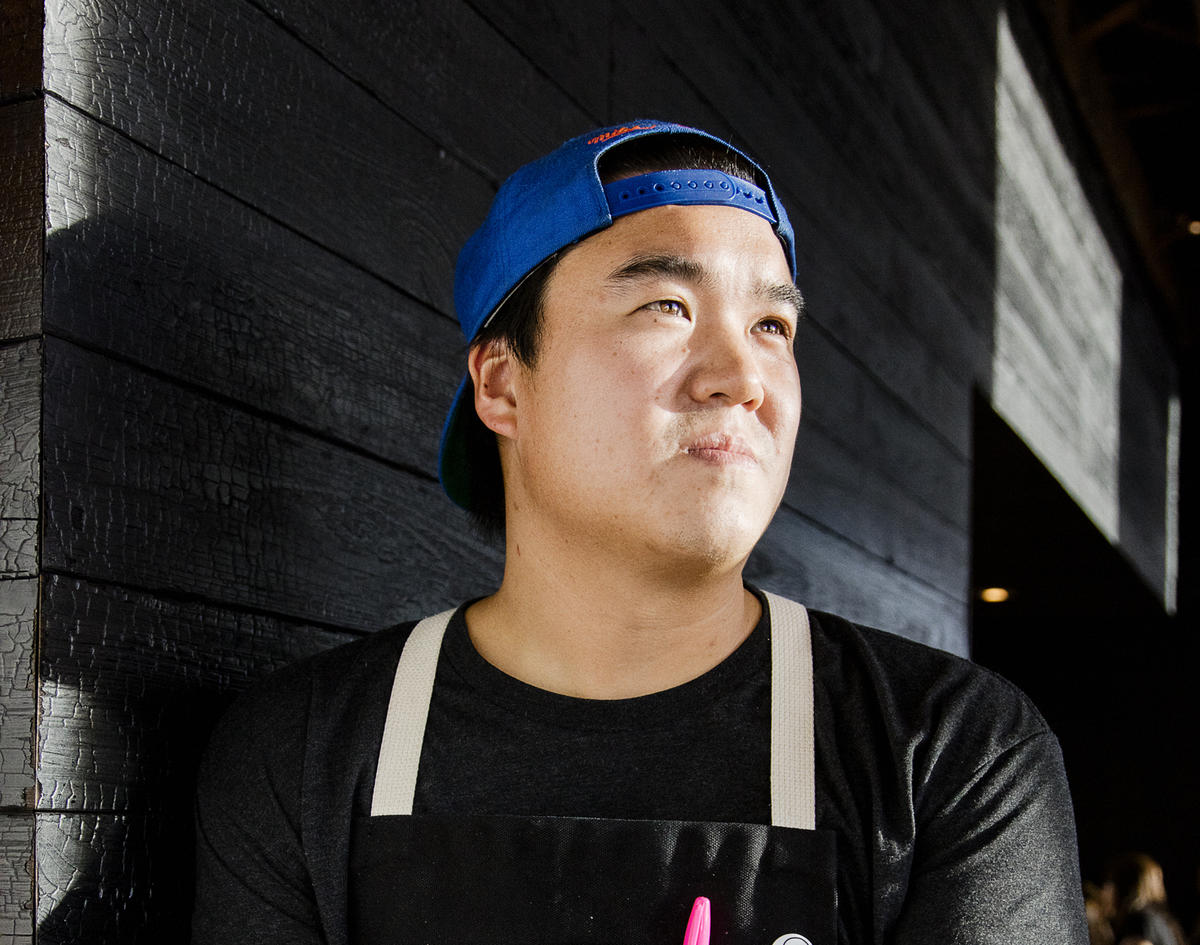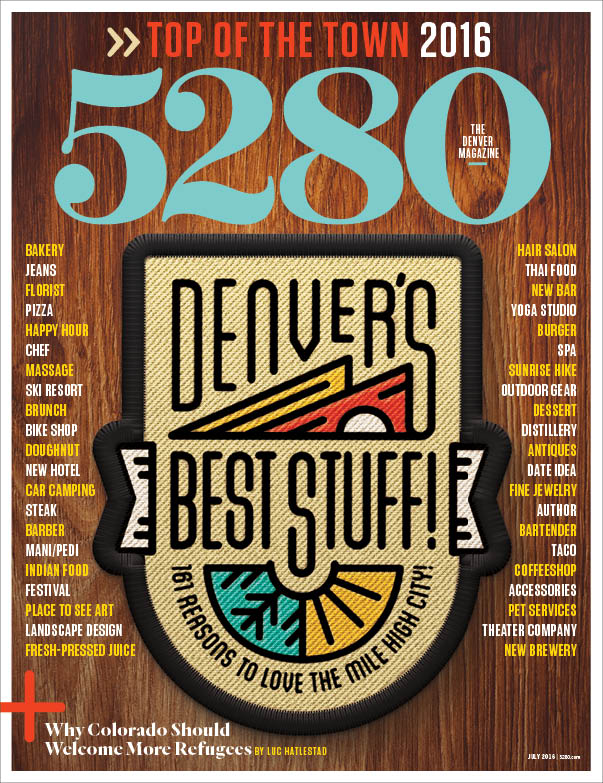The Local newsletter is your free, daily guide to life in Colorado. For locals, by locals.
Hop Alley
3.5 Stars
THE DRAW: Lively interpretations of regional Chinese dishes that don’t stray too far into fusion territory; tall cocktails to wash them down
THE DRAWBACK: Some dishes are oversalted, some undersauced
DON’T MISS: Fried chicken with Sichuan pepper, Shanghai rice cakes, suan ni pork chop with garlic, salt-and-pepper soft-shell crab
PRICE: $$
Learn more about our rating system here.
I was a quarter of the way into an eight-dish, seven-person feast at Hop Alley in RiNo when I waved my chopsticks—with which I had pincered two slippery disks of Shanghai rice cake, each bathed in oyster sauce and dotted with bits of chewy pork—and remarked to my wife, “I think this may be the best food I’ve eaten in Denver in the past year.” She cocked an eyebrow, for few things get me as giddy as a good Asian meal. This predilection dates to the time I was uprooted to Java, Indonesia, as a kid. This is where I discovered crab in black bean sauce, a dish whose miraculous existence I had not been made aware of in my home of Saskatchewan, Canada. That childhood dinner was as close as I’ve come to a religious conversion.
So, yes, I find redoubled happiness in the exuberant flavors that Hop Alley delivers. Consider its Chongqing dish called la zi ji: fried chicken morsels in an extravagance of dried red chiles, flavored with mouth-numbing Sichuan peppercorns, garlic, ginger, scallions, and sesame seeds. It’s a straight-ahead version of a straightforward dish, but it’s executed perfectly, with the seared quality that only comes from proper stir-frying. A mouthful of la zi ji, soothed by Hop Alley’s steamed jasmine rice—also properly prepared, and whose aroma greets you when you walk in the door—is a bite of heaven.
Rice is also fried at Hop Alley, with little bits of bone marrow, egg, and peas, yielding one of those dishes whose blandness, to me, is sublime: The marrow gives your lips a sticky coating. My research did not turn up marrow as a traditional ingredient in Chinese fried rice, and that brings up the authenticity question—as in, where along the spectrum from scholarly/purist to fusion/avant-garde does owner Tommy Lee’s food fall?
It lands on a felicitous spot. Lee, who also owns Uncle, is the Denver son of Hong Kong parents and has spent considerable time in that Chinese city. It may be that grounding—Hong Kong is a fusion hotbed, but deadly serious about its food—that gives Lee’s dishes (developed with chef Todd Somma, formerly of Uncle) such clarity. They avoid the fusion confusion that afflicts restaurants like Danny Bowien’s superhip Mission Chinese in New York City, where I recently ate. Bowien is the enfant terrible of fusion experimentation, but his kung pao pastrami did no favors to kung pao or pastrami, and his Chongqing chicken wings were laced with so much peppercorn that I felt like a booster cable was clamped to my tongue.

At Hop Alley, by comparison, fusion elements are recessive in the pursuit of clarity and harmony. Take the suan ni pork chop, traditionally a dish of thin-sliced pork, often boiled pork belly, served with minced garlic and a spicy soy sauce. The soy broth that drives the Hop Alley version—sweet and slightly redolent of five-spice—has a mild attack. The kitchen wood-grills a small, fatty chop to tender perfection, slices the meat very thin, then tops the dish with a blanket of minced garlic and adds bean sprouts and a scant trace of chile oil. It’s beautifully done. Similarly, the mild, thin, peanut-y bang bang sauce that accompanies slices of soft tofu doesn’t overwhelm the tofu but complements its beany, creamy flavor.
Beijing duck rolls are a bit more playful. A shard of crispy duck skin—not in the lacquered Peking duck style, alas, but fried—is served alongside the roll, which is a mass of shredded duck meat and cabbage, aromatic with hoisin sauce, wrapped up in a scallion pancake and fat as a burrito.
Seasonal soft-shell crabs are fried to a robust crispness, flavored in a style reminiscent of one of my favorite ultra-simple Vietnamese dishes: salt-and-pepper prawns. But this dish is more involved: Dip crab in a lime mayo, add chopped jalapeños and pickled onions, wrap in Bibb lettuce—well, you can imagine how good that tastes.
If there’s a downside, it’s that the saucy dishes (and there aren’t quite enough of them) aren’t always sufficiently saucy to really soak into your bowl of rice. There is a tendency to salt some dishes brutally, such as the otherwise exquisite eggplant with Sichuan bean sauce and cooling salad. The three-cup chicken was saucy, but the sauce was vague, brown, and generic.

The menu occasionally strays into Southeast Asia, as with an Isaan sausage (nicely sour in the northern Thai style) that’s served with a chunky sugar snap pea salad laced with Thai herbs. For some reason, a roasted octopus tentacle sat opposite the sausage on its own roasty-flavored chile crab paste. It might have been flung over from a nearby Mexican kitchen, because it didn’t make much sense. No matter. Give the lazy Susan a one-sixteenth turn and dig into those Shanghai rice cakes.
Which brings me to the matter of Hop Alley’s lone lazy Susan table. If you have six or more in your party, it’s the best spot in the restaurant to communally eat the food, which
arrives pell-mell in the Chinese way, cheerfully served and explained. There are other long communal tables and a few two- and four-tops in the small, modern room, faced on one side by a bustling open kitchen. I also like eating at the bar, which is tucked into an anteroom near the front door.
The bar affords a view of the admirable collection of liquors used in Hop Alley’s cocktails. Many of these are tall, fruity-sour concoctions, some with the crumbly, crushed ice Southerners adore. The bar team recently reworked the menu and renamed some drinks: The Heaven is a tart mix of gin, sherry, arrack, and passion fruit served in a plastic cup and sealed at the top with a pull-away lid. For something stronger, the old fashioned (formerly called the Dog) is a supercharged riff on the classic with high-proof bourbon, amaro, Madeira, and “smoked tea” spritzed with orange-peel oil.
I have only a couple of quibbles with Hop Alley. I get why restaurants are fussy about large-table reservations, but refusing to seat us when six of seven people have arrived starts things off on a crabby note. My other complaint is more of a suggestion: Add dessert to the menu! Desserts aren’t a strong suit in Chinese cuisine, but neither are cocktails, so that argument won’t stand. At press time, Lee mentioned he’s adding a couple of simple options. I urge him to go further. There’s enough invention afoot in the kitchen to do interesting things with gelatos, custards, pastries, and cookies. A coconut bun with soy-salted caramel, perhaps?
Nitpicking aside, I stand by my giddy conclusion from that dinner. Hop Alley is serving some of the best food in town. Call now and snag that table with the lazy Susan.









